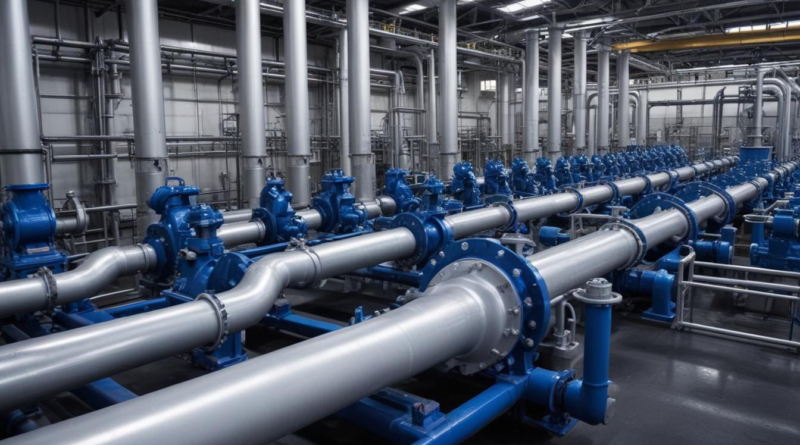the role of pumps in industrial fluid handling
Industrial fluid pumps are available in a variety of types, each designed with specific functionality to meet diverse industrial needs. The selection of the appropriate pump type plays a crucial role in ensuring efficient fluid handling and system reliability. Below is an overview of the primary categories of industrial fluid pumps:
| Type | Functionality | Applications |
|---|---|---|
| Centrifugal Pumps | Utilize rotational energy to impart velocity to fluid, converting it to pressure. | Water supply systems, HVAC, chemical processing, and petroleum refining. |
| Gear Pumps | Employ interlocking gears to move fluid, providing consistent flow rates. | Lubrication systems, hydraulic circuits, and oil transfer applications. |
| Piston Pumps | Use reciprocating pistons to displace fluid, enabling precise flow control. | Hydraulic systems, high-pressure cleaning, and fuel injection. |
| Diaphragm Pumps | Operate with a flexible diaphragm to move fluid, ideal for handling corrosive or abrasive liquids. | Chemical processing, wastewater treatment, and pharmaceuticals. |
| Peristaltic Pumps | Move fluids by compressing a flexible tube, ensuring contamination-free transfer. | Biotechnology, food and beverage industries, and medical applications. |
| Screw Pumps | Use one or more screws to transport fluid, offering smooth and steady flow with minimal pulsation. | Food processing, oil and gas, and pulp and paper industries. |
| Magnetic Drive Pumps | Transfer torque via a magnetic coupling, eliminating the need for direct seals and reducing leak risks. | Handling hazardous materials, pharmaceuticals, and cleanroom applications. |
Understanding the distinct functionality of each pump type allows industries to select the most suitable industrial fluid pumps that align with their specific operational requirements, ensuring optimal performance and longevity of their fluid handling systems.
selection criteria for pumps
Selecting the appropriate pump for industrial fluid handling involves a comprehensive evaluation of several critical factors to ensure optimal performance, longevity, and efficiency of the system. The following criteria are essential in guiding the selection process:
- Fluid Characteristics: Understanding the properties of the fluid, including viscosity, density, corrosiveness, and presence of solids or abrasives, is paramount. For instance, highly viscous or abrasive fluids may require specific pump types such as peristaltic or diaphragm pumps to prevent excessive wear and ensure reliable operation.
- Flow Rate Requirements: Determining the required flow rate, typically measured in gallons per minute (GPM) or liters per second (L/s), helps in selecting a pump that can consistently meet the demand without overloading. Accurate flow rate specifications are crucial for processes that rely on precise fluid handling.
- Pressure Specifications: The system’s pressure requirements, including both suction and discharge pressures, must align with the pump’s capabilities. High-pressure applications might necessitate the use of piston or centrifugal pumps designed to handle elevated pressures efficiently.
- Temperature Conditions: The operating temperature range of the fluid influences the choice of pump materials and seals. Pumps intended for high-temperature applications should have components that can withstand thermal stress without degradation.
- Material Compatibility: Ensuring that the pump materials are compatible with the fluid being handled is essential to prevent chemical reactions, corrosion, or contamination. For example, magnetic drive pumps are suitable for handling corrosive substances due to their leak-free design.
- Energy Efficiency: Evaluating the energy consumption of a pump can lead to significant cost savings over time. Pumps with higher efficiency ratings reduce operational costs and contribute to more sustainable industrial practices.
- Installation Space and Configuration: The physical dimensions and configuration of the pump should fit within the available space and align with the existing system layout. Compact pump designs or modular configurations can be advantageous in facilities with space constraints.
- Maintenance and Reliability: Consideration of the pump’s maintenance requirements and overall reliability is crucial for minimizing downtime and ensuring continuous operation. Pumps with easily accessible components and those designed for minimal maintenance can enhance operational efficiency.
- Cost Considerations: Balancing the initial purchase cost with the total cost of ownership, including maintenance, energy consumption, and lifespan, is important for budget-conscious operations. Investing in higher-quality pumps may result in lower long-term expenses.
- Regulatory and Safety Standards: Compliance with industry-specific regulations and safety standards is mandatory. Pumps used in sectors such as pharmaceuticals or food processing must adhere to stringent guidelines to ensure product integrity and worker safety.
The following table summarizes key selection criteria for industrial fluid pumps:
| Criteria | Considerations |
|---|---|
| Fluid Properties | Viscosity, corrosiveness, presence of solids or abrasives |
| Flow Rate | Desired GPM or L/s to meet process requirements |
| Pressure Requirements | Suction and discharge pressures needed for system operation |
| Temperature Range | Operating temperatures and thermal stability of pump materials |
| Material Compatibility | Chemical compatibility of pump materials with the fluid |
| Energy Efficiency | Energy consumption and efficiency ratings |
| Space and Configuration | Physical dimensions and layout compatibility |
| Maintenance | Ease of maintenance and reliability of components |
| Cost | Initial cost versus total cost of ownership |
| Regulatory Compliance | Adherence to industry-specific standards and safety regulations |
By meticulously assessing these criteria, industries can select industrial fluid pumps that not only fulfill their specific operational needs but also enhance the overall efficiency and reliability of their fluid handling systems. This strategic selection process plays a crucial role in optimizing performance, reducing downtime, and maintaining the integrity of industrial processes.
maintenance and troubleshooting
Routine maintenance is essential to ensure the reliable operation and longevity of industrial fluid pumps. Regular maintenance activities help in identifying potential issues before they escalate into significant problems, thereby minimizing downtime and maintaining optimal system performance. Key maintenance practices include:
- Visual Inspections: Regularly examine pump components for signs of wear, corrosion, leaks, or damage. Visual inspections should be conducted at scheduled intervals to detect early indicators of malfunction.
- Lubrication: Ensure that all moving parts, such as bearings and seals, are adequately lubricated. Proper lubrication reduces friction, prevents excessive wear, and maintains smooth operation.
- Cleaning: Keep the pump and surrounding area clean to prevent contamination and accumulation of debris. Regular cleaning helps in maintaining the functionality and efficiency of the pump.
- Seal and Gasket Checks: Inspect seals and gaskets for signs of deterioration or leakage. Replacing worn seals promptly prevents fluid loss and maintains system integrity.
- Electrical Component Maintenance: Check electrical connections, wiring, and motor components for signs of wear or damage. Ensuring the electrical components are in good condition is crucial for the safe and efficient operation of the pump.
- Performance Monitoring: Continuously monitor pump performance metrics such as flow rate, pressure, and temperature. Deviations from normal operating conditions can indicate underlying issues that need to be addressed.
In addition to routine maintenance, effective troubleshooting is vital for diagnosing and resolving pump-related issues promptly. Common problems and their solutions include:
| Problem | Possible Cause | Solution |
|---|---|---|
| Pump Not Operating | Electrical failure, power supply issues, or motor malfunction. | Check electrical connections, verify power supply, and inspect the motor for faults. Replace or repair faulty components as necessary. |
| Reduced Flow Rate | Clogged intake, worn impeller, or air leaks in the system. | Clean the intake filter, inspect and replace the impeller if worn, and identify and seal any air leak points. |
| Excessive Noise | Misalignment, bearing wear, or cavitation. | Align the pump properly, replace worn bearings, and ensure adequate NPSH (Net Positive Suction Head) to prevent cavitation. |
| Overheating | Insufficient cooling, blocked vents, or excessive load. | Ensure proper cooling mechanisms are functioning, clear any blocked vents, and verify that the pump is not operating beyond its rated capacity. |
| Leaking Seals | Worn or damaged seals, improper installation, or excessive pressure. | Replace damaged seals, ensure correct installation procedures are followed, and adjust system pressure to recommended levels. |
Implementing a structured maintenance schedule and adhering to best practices significantly contributes to the functionality and reliability of industrial fluid pumps. Additionally, maintaining detailed maintenance records aids in tracking the performance history of each pump, facilitating informed decision-making for repairs, replacements, and upgrades. Advanced diagnostic tools and technologies, such as vibration analysis and thermal imaging, can further enhance troubleshooting capabilities by providing real-time data on pump health.
Proactive maintenance not only extends the lifespan of pumps but also plays a critical role in ensuring the efficiency and safety of industrial fluid handling systems. By prioritizing maintenance and troubleshooting, industries can achieve uninterrupted operations, reduce operational costs, and maintain high standards of performance.
energy efficiency considerations
 Energy efficiency is a critical factor in the operation of industrial fluid pumps, directly impacting both operational costs and environmental sustainability. Optimizing the energy consumption of these pumps not only reduces expenses but also minimizes the carbon footprint of industrial processes. Several key considerations contribute to enhancing the energy efficiency of pump systems:
Energy efficiency is a critical factor in the operation of industrial fluid pumps, directly impacting both operational costs and environmental sustainability. Optimizing the energy consumption of these pumps not only reduces expenses but also minimizes the carbon footprint of industrial processes. Several key considerations contribute to enhancing the energy efficiency of pump systems:
- Proper Pump Selection: Choosing the right pump type and size based on the specific application ensures that the pump operates within its optimal efficiency range. Oversized or undersized pumps can lead to excessive energy use and decreased performance.
- Variable Frequency Drives (VFDs): Implementing VFDs allows for the adjustment of the pump’s motor speed to match the required flow and pressure. This adaptability reduces energy consumption during periods of lower demand.
- System Design Optimization: Designing the piping system to minimize friction losses, eliminating unnecessary bends, and ensuring proper alignment can significantly enhance pump efficiency. Efficient system design reduces the workload on the pump, leading to lower energy usage.
- Regular Maintenance: Keeping pumps well-maintained ensures that they operate efficiently. Issues such as clogged filters, worn impellers, or air leaks can degrade pump performance and increase energy consumption.
- Energy Recovery Systems: In certain applications, energy recovery devices can capture and reuse energy from the fluid flow, improving the overall energy efficiency of the system.
In addition to these practices, advancements in pump technology have introduced several energy-efficient solutions tailored to industrial needs:
| Energy-Efficient Technology | Description | Benefits |
|---|---|---|
| Magnetic Drive Pumps | Pumps that use magnetic couplings to eliminate mechanical seals, reducing energy loss and minimizing leaks. | Enhanced safety, reduced maintenance, and improved energy efficiency. |
| High-Efficiency Motors | Motors designed to operate at higher efficiencies, often complying with international energy standards. | Lower energy consumption and reduced operational costs. |
| Advanced Control Systems | Integrated systems that monitor and adjust pump operation in real-time to maintain optimal performance. | Increased precision, reduced energy waste, and enhanced system responsiveness. |
| Load Sensing Pumps | Pumps that adjust their output based on the actual load demand, ensuring that energy is not wasted during low-demand periods. | Significant energy savings and improved system flexibility. |
Implementing these energy-efficient technologies and practices plays a vital role in the functionality and sustainability of industrial fluid handling systems. Businesses can achieve substantial cost savings and contribute to environmental conservation by focusing on energy efficiency. Moreover, regulatory pressures and the global emphasis on reducing energy consumption make it imperative for industries to adopt energy-efficient pump solutions.
To further enhance energy efficiency, industries can consider the following strategies:
- Energy Audits: Conduct comprehensive energy audits to identify areas where energy consumption can be reduced and efficiency can be improved.
- Training and Awareness: Educate maintenance personnel and operators about best practices for energy-efficient pump operation and maintenance.
- Performance Monitoring: Utilize monitoring tools and software to continuously track pump performance and identify opportunities for optimization.
- Upgrade Existing Systems: Retrofit older pump systems with modern, energy-efficient components to enhance overall performance and reduce energy usage.
By integrating these approaches, industries can ensure that their industrial fluid pumps not only perform their intended functions effectively but also operate in an energy-conscious manner. This balanced focus on efficiency and performance is essential for maintaining competitive advantage and achieving long-term sustainability goals.
applications in various industries
Industrial fluid pumps are integral to a wide range of industries, each leveraging their unique functionality to meet specific operational requirements. The versatility and adaptability of these pumps enable efficient fluid handling, contributing significantly to the productivity and reliability of industrial processes. Below are some key sectors where industrial fluid pumps play a pivotal role:
| Industry | Applications | Suitable Pump Types |
|---|---|---|
| Chemical Processing | Transporting corrosive chemicals, mixing reactants, and transferring hazardous substances. | Diaphragm pumps, magnetic drive pumps, centrifugal pumps. |
| Oil and Gas | Extraction, transportation, and refining of petroleum products, as well as handling of drilling fluids. | Positive displacement pumps, centrifugal pumps, screw pumps. |
| Food and Beverage | Processing ingredients, packaging, and transferring sanitary liquids. | Peristaltic pumps, sanitary centrifugal pumps, diaphragm pumps. |
| Pharmaceuticals | Formulation, mixing, and sterile transfer of medicinal liquids. | Sanitary centrifugal pumps, magnetic drive pumps, diaphragm pumps. |
| Water and Wastewater Treatment | Pumping water through treatment processes, sludge handling, and chemical dosing. | Centrifugal pumps, submersible pumps, peristaltic pumps. |
| Power Generation | Water circulation in cooling systems, fuel supply, and boiler feedwater systems. | Centrifugal pumps, axial flow pumps, mixed flow pumps. |
| Pulp and Paper | Transporting pulp, chemicals, and wastewater within the production process. | Gear pumps, centrifugal pumps, screw pumps. |
| Automotive | Cooling systems, lubrication, and fuel injection systems. | Gear pumps, piston pumps, centrifugal pumps. |
| HVAC | Heating and cooling systems, including water circulation and refrigerant transfer. | Centrifugal pumps, submersible pumps, magnetic drive pumps. |
Each industry demands pumps that can handle specific challenges, such as corrosive fluids in chemical processing or sanitary requirements in food and beverage production. For instance, in the chemical processing sector, diaphragm pumps and magnetic drive pumps are favored for their ability to manage corrosive and hazardous liquids without compromising system integrity. Similarly, the food and beverage industry relies on peristaltic and sanitary centrifugal pumps to ensure hygienic handling and prevent contamination.
In the oil and gas industry, the robustness of positive displacement and centrifugal pumps is essential for managing the high pressures and abrasive fluids encountered during extraction and refining processes. These pumps are designed to withstand harsh environments and maintain consistent performance under demanding conditions.
The pharmaceutical industry emphasizes the need for sterile and precise fluid handling, making sanitary centrifugal pumps and magnetic drive pumps ideal choices. These pumps help maintain the stringent quality standards required for medicinal liquid production.
Water and wastewater treatment facilities utilize centrifugal and submersible pumps to efficiently move large volumes of water through various treatment stages. These pumps are critical for ensuring a clean and safe water supply while managing the complexities of wastewater disposal.
In power generation, centrifugal and axial flow pumps play a crucial role in maintaining the necessary water circulation within cooling systems and providing fuel to boilers. The reliability and efficiency of these pumps directly impact the overall performance and safety of power plants.
The pulp and paper industry depends on gear and screw pumps to handle the viscous pulp and chemical solutions used in the manufacturing process. These pumps are selected for their ability to provide steady flow rates and resist wear from abrasive materials.
Automotive manufacturing incorporates gear and piston pumps in various applications, including engine cooling and lubrication systems. These pumps ensure that critical components receive the necessary fluids to operate smoothly and efficiently.
Finally, the HVAC sector relies on centrifugal and magnetic drive pumps to circulate water and refrigerants within heating and cooling systems. The energy efficiency and reliability of these pumps are vital for maintaining comfortable indoor environments and reducing energy consumption.
- Chemical Processing: Efficient handling of corrosive and hazardous fluids with minimal maintenance requirements.
- Oil and Gas: Robust performance under high pressure and abrasive conditions for extraction and refining.
- Food and Beverage: Hygienic and contamination-free fluid transfer to meet strict sanitary standards.
- Pharmaceuticals: Precise and sterile pumping solutions to ensure product integrity.
- Water and Wastewater Treatment: High-capacity pumps for effective water management and treatment processes.
- Power Generation: Reliable circulation and fuel supply systems critical for operational safety and efficiency.
- Pulp and Paper: Steady and durable pumps to handle viscous and abrasive materials.
- Automotive: Essential fluid management for cooling, lubrication, and fuel systems.
- HVAC: Efficient circulation of water and refrigerants to maintain indoor climate control.
The role of industrial fluid pumps extends beyond mere fluid transport; they are fundamental to the operational success and sustainability of diverse industrial activities. As technology advances, the integration of smart and energy-efficient pump systems continues to enhance their functionality, making them indispensable assets in modern industrial settings.




